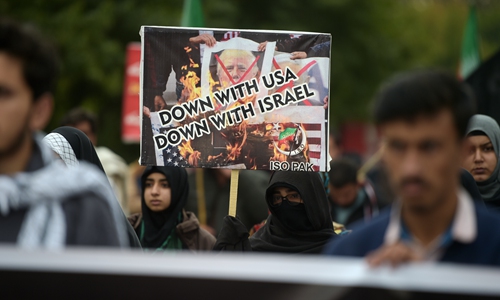Washington eyes short-term interest with assassination

Protesters shout slogans against the US during a demonstration following a US airstrike that killed top Iranian commander Qasem Soleimani in Iraq, in Islamabad on January 3. Photo: AFP
The US killed Iranian Major-General Qassem Soleimani, head of the Quds Force of the Islamic Revolutionary Guard Corps, and Abu Mahdi al-Muhandis, a commander of Iraq's Shia Hashd al-Shaabi, or Popular Mobilization Units, in an early-morning drone strike on Friday. The US operation shook the Middle East. Iran's Supreme Leader Ayatollah Ali Khamenei threatened "a harsh retaliation" against the US. The US Embassy in Baghdad and the US State Department on Friday called on Americans in Iraq to "immediately leave" Iraq.
This round of escalating conflicts between the US and Iran dates back to December 27, 2019 when a rocket attack hit a US base in northern Iraq, killing an American contractor and wounding four American servicemen. Two days later, the US bombed Kata'ib Hezbollah, an Iraqi Shia armed group, killing 25 members of the militia, and accused Iran of being behind the rocket attack. Then the US Embassy in Iraq was besieged on December 31, which Washington once again believed Iran should be "held fully responsible" for. Soleimani's removal is the latest escalation of tensions.
More information is needed to understand the situation. The US overthrew the regime of Saddam Hussein through war in 2003, but the Iraqi situation didn't develop as the US expected. The country's politics has had more sectarian and tribal features. Shias account for more than 60 percent of Iraq's population, which provides Tehran with much room for activities in Iraq. For some forces in Iran and Iraq, Soleimani's trip to Baghdad was a normal exchange and they regarded the US action against him as "assassination" and an "international terrorist act."
The US previously designated the Quds Force as a foreign terrorist organization. The US and Iran accuse each other of terrorism and engage in tit-for-tat confrontations. Is this what Washington wants?
The US has bigger power and strength. It easily killed an important Iranian official. But how much hatred will be aroused among Shia Muslims by Soleimani's death? Will the American personnel in the Middle East become safer?
One certain thing is that the US action will cause much more anger and hostility than fear against the US in Iran and areas that support Iran. Since the war in Afghanistan, the US has killed many senior officials and even leaders of its deemed rivals. With the high price it paid, did Washington successfully deter those in the Middle East who hate the US? The answer is apparently no. Anti-US forces have been growing all the time.
From the US assisting Israelis in fighting and negotiating with Arabs, to its support for the "Arab Spring" to helping Israel and Sunni regimes confront Shia regimes, the US has always had enemies in the Middle East.
Washington has underestimated the serious political consequences of killing Soleimani. The warning of "a harsh retaliation" by Khamenei is more than just a threat, but represents the sentiment and voice of Shia society in the Middle East. Even if the Iranian government doesn't retaliate, how about some regional forces?
The US is too powerful. Facing a challenge, it tends to believe the use of force is the best choice. But the use of force can only lead to death. It cannot transform people's will.
It's fair to say the US Middle East policy is a failure. Washington today cares more about how to woo American voters to support the current government. It has little interest in working out a long-term solution to the Middle East problem, but is more willing to conduct short-term operations.